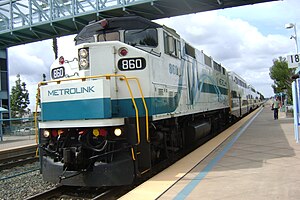Orange County Line
| Orange County Line | |||
|---|---|---|---|
 Metrolink train 860 at Irvine | |||
| Overview | |||
| Status | Operating | ||
| Owner | BNSF Railway (Los Angeles–Fullerton) SCRRA (Fullerton–San Clemente Pier) NCTD (San Clemente Pier–Oceanside) | ||
| Locale | Los Angeles, Orange, and San Diego Counties | ||
| Termini | |||
| Stations | 14 | ||
| Service | |||
| Type | Commuter rail | ||
| System | Metrolink | ||
| Operator(s) | Metrolink | ||
| Technical | |||
| Line length | 87.2 miles (140.3 km) | ||
| Character | Elevated and surface-level | ||
| Track gauge | 1,435 mm (4 ft 8+1⁄2 in) | ||
| Operating speed | 41 mph (66 km/h)[1] | ||
| |||
The Orange County Line is a commuter rail line run by Metrolink from Los Angeles through Orange County to Oceanside in San Diego County, connecting with the Coaster commuter rail service to San Diego. The Orange County Line carries passengers to the primary Metrolink hub at Union Station in downtown Los Angeles, as well as to many attractions in Orange County including Angel Stadium of Anaheim and the Honda Center, the Disneyland Resort, Old Town Orange, and Mission San Juan Capistrano.[citation needed]
History
The Orange County Line began in 1990 as the Orange County Commuter, an Amtrak-operated service between Los Angeles and San Juan Capistrano. The Orange County Commuter made a single weekday round-trip; departing San Juan Capistrano in the morning and returning in the evening.[2] Amtrak conveyed the route to Metrolink on March 28, 1994, becoming the "Orange County Line" and Metrolink's fifth route.[3][4] Service is provided seven days a week, with 19 trains on weekdays, and six on weekends. The Amtrak Pacific Surfliner supplements Orange County Line service by providing limited stop service along the corridor and more service during mid-days, nights and weekends.
Route
While the Orange County Line shares trackage with Amtrak's Pacific Surfliner trains, a few of its stations are shared with the 91 Line and many with the IEOC line.
The Orange County Line runs on the BNSF Railway's Southern Transcon track between Los Angeles and Fullerton, under a shared-right-of-way agreement. Several stations, most notably the ones in downtown Fullerton and Santa Ana, are renovated Spanish Colonial Revival depots originally built by the Atchison, Topeka and Santa Fe Railway.
In October 2005, the Orange County Transportation Authority announced that it would increase service on the Orange County Line, running trains twenty hours daily, seven days a week every 30 minutes. The first part of the additional service was implemented in June 2006 with Saturday service, and July 2006 with Sunday service. The plan has drawn criticism[citation needed] as many Metrolink stations are located beyond walking distance from important destinations such as Disneyland and the adjacent Anaheim Convention Center, Knott's Berry Farm, and the Irvine Spectrum. Funds for new rolling stock and track improvements were allocated from the voter-approved Measure M half-cent sales tax, while critics had advocated using the money for bus operations or other transit service instead. To address some of these issues, OCTA operates a series of Stationlink shuttle routes that connect Metrolink stations in Orange County to nearby destinations.
The Orange County line serves 14 stations during weekday service, and one additional station on weekends:
- Union Station, Los Angeles
- Commerce, Commerce
- Norwalk/Santa Fe Springs, Norwalk
- Buena Park, Buena Park
- Fullerton, Fullerton
- Anaheim Regional Transportation Intermodal Center, Anaheim
- Orange, Orange
- Santa Ana, Santa Ana
- Tustin, Tustin
- Irvine, Irvine
- Laguna Niguel/Mission Viejo, Laguna Niguel/Mission Viejo
- San Juan Capistrano, San Juan Capistrano
- San Clemente, San Clemente
- San Clemente Pier, San Clemente (weekend service only)
- Oceanside, Oceanside
The July 2011 timetable shows five weekday trains from Los Angeles to Oceanside, three to Laguna Niguel and one to Irvine.
California High-Speed Rail
The route of the Orange County Line will be used for the planned California High-Speed Rail line from Los Angeles Union Station to Irvine. It will stop in Anaheim and possibly either Norwalk or Fullerton. When completed, the right-of-way will consist of the existing tracks with two additional tracks for HSR trains.
See also
References
- ^ "Metrolink Fact Sheet for June 2012" (PDF). Metrolink. Retrieved 26 October 2012.
- ^ Amtrak (October 28, 1990). "National Train Timetables". Retrieved 2010-05-16.
- ^ NARP (March 25, 1994). "NARP March 1994 Hotlines". Retrieved 2010-05-16.
- ^ TRAINS Magazine - Railroad News, Web Cam, Railroading Video - Metrolink
